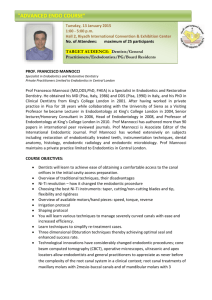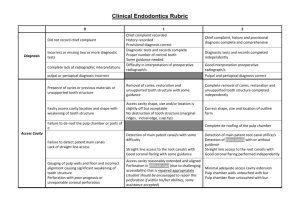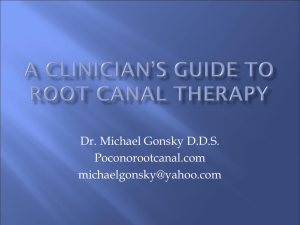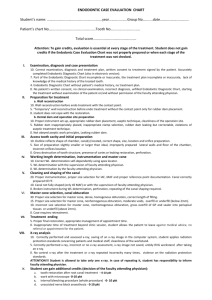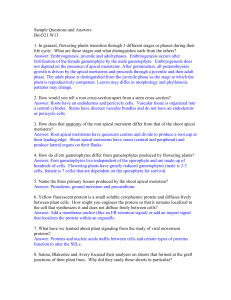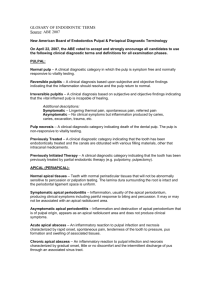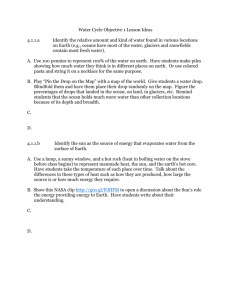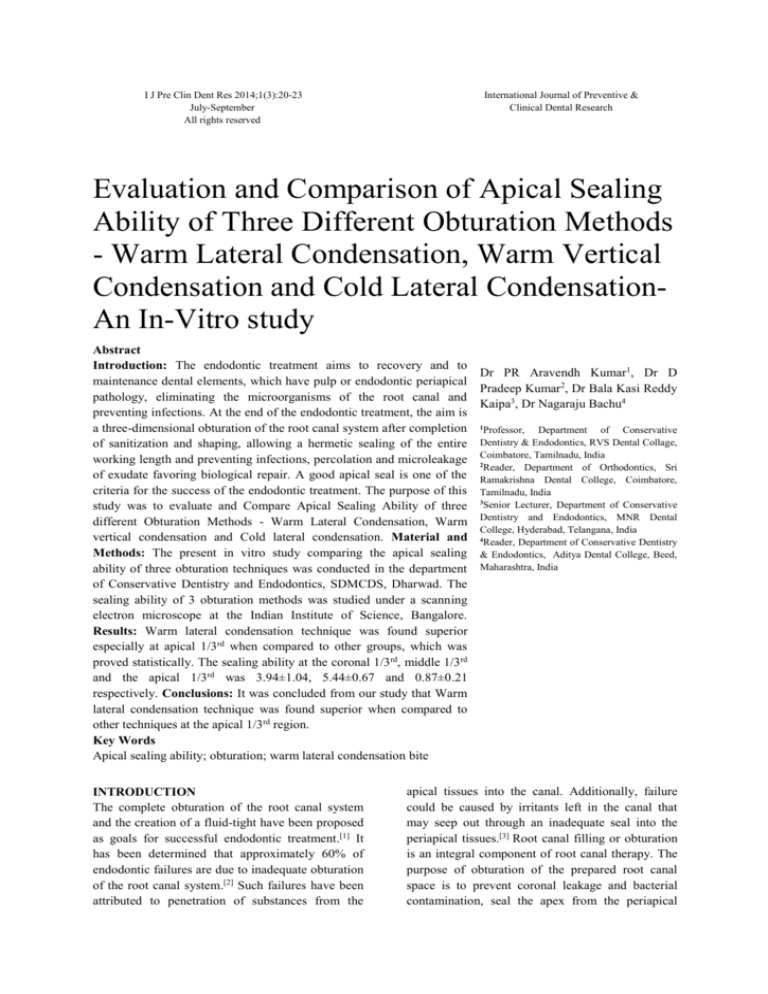
I J Pre Clin Dent Res 2014;1(3):20-23
July-September
All rights reserved
International Journal of Preventive &
Clinical Dental Research
Evaluation and Comparison of Apical Sealing
Ability of Three Different Obturation Methods
- Warm Lateral Condensation, Warm Vertical
Condensation and Cold Lateral CondensationAn In-Vitro study
Abstract
Introduction: The endodontic treatment aims to recovery and to
maintenance dental elements, which have pulp or endodontic periapical
pathology, eliminating the microorganisms of the root canal and
preventing infections. At the end of the endodontic treatment, the aim is
a three-dimensional obturation of the root canal system after completion
of sanitization and shaping, allowing a hermetic sealing of the entire
working length and preventing infections, percolation and microleakage
of exudate favoring biological repair. A good apical seal is one of the
criteria for the success of the endodontic treatment. The purpose of this
study was to evaluate and Compare Apical Sealing Ability of three
different Obturation Methods - Warm Lateral Condensation, Warm
vertical condensation and Cold lateral condensation. Material and
Methods: The present in vitro study comparing the apical sealing
ability of three obturation techniques was conducted in the department
of Conservative Dentistry and Endodontics, SDMCDS, Dharwad. The
sealing ability of 3 obturation methods was studied under a scanning
electron microscope at the Indian Institute of Science, Bangalore.
Results: Warm lateral condensation technique was found superior
especially at apical 1/3rd when compared to other groups, which was
proved statistically. The sealing ability at the coronal 1/3rd, middle 1/3rd
and the apical 1/3rd was 3.94±1.04, 5.44±0.67 and 0.87±0.21
respectively. Conclusions: It was concluded from our study that Warm
lateral condensation technique was found superior when compared to
other techniques at the apical 1/3rd region.
Key Words
Apical sealing ability; obturation; warm lateral condensation bite
INTRODUCTION
The complete obturation of the root canal system
and the creation of a fluid-tight have been proposed
as goals for successful endodontic treatment.[1] It
has been determined that approximately 60% of
endodontic failures are due to inadequate obturation
of the root canal system.[2] Such failures have been
attributed to penetration of substances from the
Dr PR Aravendh Kumar1, Dr D
Pradeep Kumar2, Dr Bala Kasi Reddy
Kaipa3, Dr Nagaraju Bachu4
1
Professor, Department of Conservative
Dentistry & Endodontics, RVS Dental Collage,
Coimbatore, Tamilnadu, India
2
Reader, Department of Orthodontics, Sri
Ramakrishna Dental College, Coimbatore,
Tamilnadu, India
3
Senior Lecturer, Department of Conservative
Dentistry and Endodontics, MNR Dental
College, Hyderabad, Telangana, India
4
Reader, Department of Conservative Dentistry
& Endodontics, Aditya Dental College, Beed,
Maharashtra, India
apical tissues into the canal. Additionally, failure
could be caused by irritants left in the canal that
may seep out through an inadequate seal into the
periapical tissues.[3] Root canal filling or obturation
is an integral component of root canal therapy. The
purpose of obturation of the prepared root canal
space is to prevent coronal leakage and bacterial
contamination, seal the apex from the periapical
21
Apical sealing ability of three different obturation methods
tissue fluids, and also seal the remaining irritants in
the canal.[4] A plethora of laboratory studies can be
found in literature; and, in contrast, clinical studies
are scanty. The laboratory studies can be carried out
with the objective of comparing the sealing ability
and adaptation of the guttapercha points under
virtual conditions, which is easier as compared to
carrying out the study in a patient’s mouth. This
explains why the former are higher in number.
Clinical trials in comparison are more challenging
as they require long term follow up and objective
assessment is more difficult. However, inspite of
these limitations, clinical trials provide more useful
and provide practical information for clinically
relevant decision making.[5] The purpose of the
study was to evaluate and compare Apical Sealing
Ability of three different Obturation Methods Warm Lateral Condensation, Warm vertical
condensation and Cold lateral condensation.
MATERIALS AND METHODS
The present in vitro study comparing the sealing
ability of three obturation techniques was conducted
in the department of Conservative Dentistry and
Endodontics, SDMCDS, Dharwad. The sealing
ability of 3 obturation methods was studied under a
scanning electron microscope at the Indian Institute
of Science, Bangalore.
Criteria for selection of teeth:
1. Non-carious teeth
2. Straight roots
3. Closed apex
The teeth were stored in 10% formalin solution.
They were cleaned using 20% H2O2 to remove soft
remaining tissue surrounding the teeth. The crowns
of the teeth were removed at cement-enamel
junction before access opening. After pulp tissue
removal with broach, number 15 K- file was
introduced into the canal of each specimen until it
was seen just near the foramen. The working length
was determined by subtracting 1mm from this
length. The canals were prepared using
circumferential filing with the apical matrix formed
with the no. 50 file. After drying the canals
thoroughly with paper points, zinc oxide powder
and eugenol were taken on a clean, dry glass slab
and mixed according to the manufacturer’s
instructions. The mixed material was placed in the
root canal with the help of a lentulospiral to apply a
thin coat on the walls of the canal. The teeth were
divided into control group and experimental group,
the first groups of 6 teeth were used as control
group and second group of 30 teeth were used as the
Kumar PRA, Kumar DP, Kaipa BKR, Bachu N
experimental group. In control group single cone
method was used. The experimental groups were
divided into three groups namely, Cold lateral
condensation
(Group
A),
Warm
Lateral
Condensation (Group B) and Warm vertical
condensation
(Group
C).
Warm
lateral
condensation: After placing the master cone to its
proper depth, a cordless, rechargeable, battery
operated GP heat condenser, ENDOTEC (Caulk,
Dentsply) was used to provide uniform heat to the
gutta percha mass. The heat condenser tip which
was introduced alongside the master GP cone was
with an ordinary spreader. After switching the
activator button on, the condenser was gently forced
apically and laterally into the canal with the rotary
penetrating motion. It was placed for 6-15 seconds
and then space just created by the condenser tip.
The same procedure was repeated until the canal
was
completely
filled.
Warm
vertical
condensation: For this technique various hand held
pluggers were used. Three pluggers, whose
diameter were just slightly less than that of the canal
preparation at any level were selected for working
on the coronal, middle and apical one third of the
canal. Following sealer placement and master cone
insertion, a spreader was heated in a glass sterilizer
and allowed to plunge 3-4 mm into the apical most
extent of GP and was allowed to remain there till it
began to cool, afterwards it was removed and the
largest prefitted plugger used to vertically pack the
GP mass apically. The procedure was repeated till
the canal was fully fitted. Cold lateral
condensation: The apical portion of the master
gutta percha cone was coated with sealer and
inserted slowly and gently into the canal to the
measured length. A hand held spreader was inserted
slowly and gently into the canal to the measured
length. A hand held spreader was inserted apically
alongside the master cone, wedging it against the
canal wall and creating space for additional cone.
The process was repeated several times until the
wedged cones blocked further access to the canal.
The protruding butt ends of the cones were removed
with the blade and of the spreader instrument heated
hot and GP mass was firmly condensed. The teeth
were sectioned horizontally in three sections
(coronal, middle and apical) with diamond disc.
Sectioned parts were coated with 20 mm of gold
palladium. They were later mounted on aluminum
studs and were examined under Scanning Electron
Microscope (SEM).
22
Apical sealing ability of three different obturation methods
Kumar PRA, Kumar DP, Kaipa BKR, Bachu N
Table 1: Analysis between the three obturation techniques for the sealing ability at the apical 1/3 rd
Source of variation
Sum of squares
Degree of freedom
Mean sum of squares
Between groups
80.57
2
40.28
Within groups
22.37
27
0.83
Total
102.93
29
Variation rate
48.63
p-value
<0.001
Table 2: Significant difference in the sealing ability between individual techniques
Sealing ability (µm)
F- value*
Obturation techniques
Range
Mean
0.48-1.24
0.87
0.21
B) Warm vertical condensation
1.76-4.75
3.50
0.92
2.50-6.04
4.81
Difference between groups
S.D.
A) Warm lateral condensation
C) Cold lateral condensation
S.D.**
48.63
p<0.001
1.30
1.26
A-B
p<0.01
A-C
p<0.01
B-C
p<0.01
*One factor ANOVA
**Least significant difference
Table 3: The sealing ability of warm lateral condensation at the coronal 1/3 rd, middle 1/3rd and the apical 1/3rd
Region
Warm lateral condensation
Coronal 1/3
3.97±1.04
Middle 1/3
5.44±0.67
Apical 1/3
RESULTS
In this in vitro study maxillary central incisors were
chosen with single patent canals. They were
obturated using three different techniques. ANOVA
analysis was done between the three obturation
techniques for the sealing ability at the apical 1/3 rd
and it was found out that there was significant
difference (F=48.63 and p<0.001) [Table 1]. Further
to find out the significant difference in the sealing
ability between individual techniques F test was
performed. The results of F test are as follows
[Table 2]:
1. Between warm lateral condensation and warm
vertical condensation the mean difference was
0.87 and 3.50 (p<0.01) which was significant.
2. Between warm lateral condensation and cold
lateral condensation the mean difference was
0.87 and 4.81 (p<0.01) which was significant.
3. Between warm vertical condensation and cold
lateral condensation the mean difference was
3.50 and 4.81 (p<0.01) which was significant.
Warm lateral condensation technique was found
superior especially at apical 1/3rd when compared to
other groups, which was proved statistically. The
sealing ability at the coronal 1/3rd, middle 1/3rd and
the apical 1/3rd was 3.94±1.04, 5.44±0.67 and
0.87±0.21 respectively [Table 3].
0.87±0.21
DISCUSSION
A major objective of endodontic obturation is to
completely obliterate and seal the root canal system
while maintaining accurate apical control of the
filling material.[6] The Washington study of
endodontic success and failure suggests apical
percolation of periradicular exudates into the
incompletely filled canals as the greatest cause of
endodontic failures.[7] Although apical percolation
may be considered as a logical hypothesis.
However, the role of the end products of
microleakage in the production of periradicular
inflammation is open to speculation.[8] It would
seem safe to assume that noxious products leaking
from the apical foramen acts as an inflammatory
irritants.[9] Thus unless the canal lumen is sealed by
obturation,
the
irritants,
metabolites
and
microorganism that may cause periapical
breakdown have the opportunity to return, which
may lead to recurrence or flare up of the perexisting lesion. Matloff et al.,[10] showed that
methylene blue dye penetrates further than
radioisotopes, thereby giving a more accurate
assessment of marginal leakage. Dental application
for dye recovery method (spectrophotometry) was
first described by Douglas and Zakariasen. This
method minimizes human measurement error and
provides determinations of volume leakage rather
23
Apical sealing ability of three different obturation methods
than liner measurement. In case of Thermafil
obturating technique during the study as well as
radiographically maximum specimen showed
extrusion of the sealer.[6,11,12] The present study has
shown that Warm lateral condensation technique
was found superior especially at apical 1/3rd when
compared to other groups. The results of this study
can be correlated with the previous studies.[12,13]
Lumnije K, Weiglein A, Städtler P radigraphically
assessed five obturation techniques and concluded
that All thermoplastic obturation techniques
demonstrated acceptable root canal filling and
sealed well with no statistically significant
difference between them and in comparison to
lateral condensation.[14] In a study.[15] the ability of
filling the lateral canals was tested, it was observed
that thermoplastic techniques generate a better
filling of these than lateral condensation. According
to a study,[16] to an increase in successful
endodontic treatment, the root canal system should
be effectively sealed at the coronal and apical
region being the apical sealing the main barrier to
infiltration. In their study comparing three
obturation techniques, there were better results in
the techniques of heated Gutta-percha compared to
cold lateral condensation techniques, with no
significant differences between the techniques of
Gutta-percha heated.
CONCLUSIONS
It was concluded from our study that Warm lateral
condensation technique was found superior when
compared to other techniques at the apical 1/3rd
region. However, further studies a need to be
conducted in this regard.
REFERENCES
1. Schilder H. Filling root canals in three
dimensions. Dent Clin North Am 1967;11:
723-44.
2. Ingle JI, Bakland LF. Endodontics. 4th ed.
Philadelphia: Lea & Febiger; 1994.
3. Kytridou V, Gutmann JL, Nunn MH.
Adaptation
and
sealability
of
two
contemporary obturation techniques in the
absence of the dentinal smear layer. Int Endod
J 1999;32(6):464-74.
4. Cohen S, Hargreaves KM. Pathways of the
pulp. St. Louis: Mosby Elsevier; 2005.
5. Peng L, Ye L, Tan H, Zhou X. Outcome of
root canal obturation by warm gutta‑percha
versus cold lateral condensation: A meta‑
analysis. J Endod 2007;33:106‑9.
6.
7.
8.
9.
10.
11.
12.
13.
14.
15.
16.
Kumar PRA, Kumar DP, Kaipa BKR, Bachu N
Clark DS, Eldeeb ME. Apical sealing ability
of metal versus plastic carriers Thermafil
obturators. J Endod 1993;19(1):4-9.
Ingle J, Bakland LK. Endodontics. Williams
and Wilkins. 4th ed. Malvern 1994; 228.
Brosco VH, Bernardineli N, Moraes IG. In
vitro" evaluation of the apical sealing of root
canals obturated with different techniques. J
Appl Oral Sci 2003;11(3):181-5.
Anil K, Shivanna V, Thomas N, Shivamurthy
G. Comparative evaluation of the apical
sealing ability and adaptation to dentine of
three resin-based sealers: An in vitro study. J
Conserv Dent 2011;14(1):16-20.
Haddix JE, Michael J. An invitro study of the
quality of root filling in teeth obturated by
lateral condensation of Gutta percha or
thermafil obturators. International Endodontic
Journal 1997;26:99-105.
Eldeeb ME, Zucker KJ, Messer H. Apical
leakage in relation to radiographic density of
gutta-percha using different obturation
techniques. J Endod 1985;11(1):25-9.
Clinton K, Van Himel T. Comparison of warm
gutta-percha obturation technique and lateral
condensation. J Endod 2001;27(11):692-5.
BeattyRG, Haddix J, Baker S, Hart F. The
Efficacy of four root canal obturation
techniques preventing apical dye penetration. J
Am Dent Assoc 1989;119(5):633-7.
Kqiku L, Weigiein A, Stadtler P. A
Comparative Study of Five Different
Obturation Techniques. Acta Stomatol Croat
2006;40(1):3-11.
Carvalho-Sousa B, Almeida-Gomes F,
Carvalho PR, Maníglia-Ferreira C, GurgelFilho ED, Albuquerque DS. Filling lateral
canals: Evaluation of different filling
techniques. Eur J Dent 2010;4(3):251-6.
Collins J, Walker MP, Kulild J, Lee C.
Acomparison of three gutta-percha obturation
techniques to replicate canal irregularities. J
Endod 2006;32(8):762-5.

